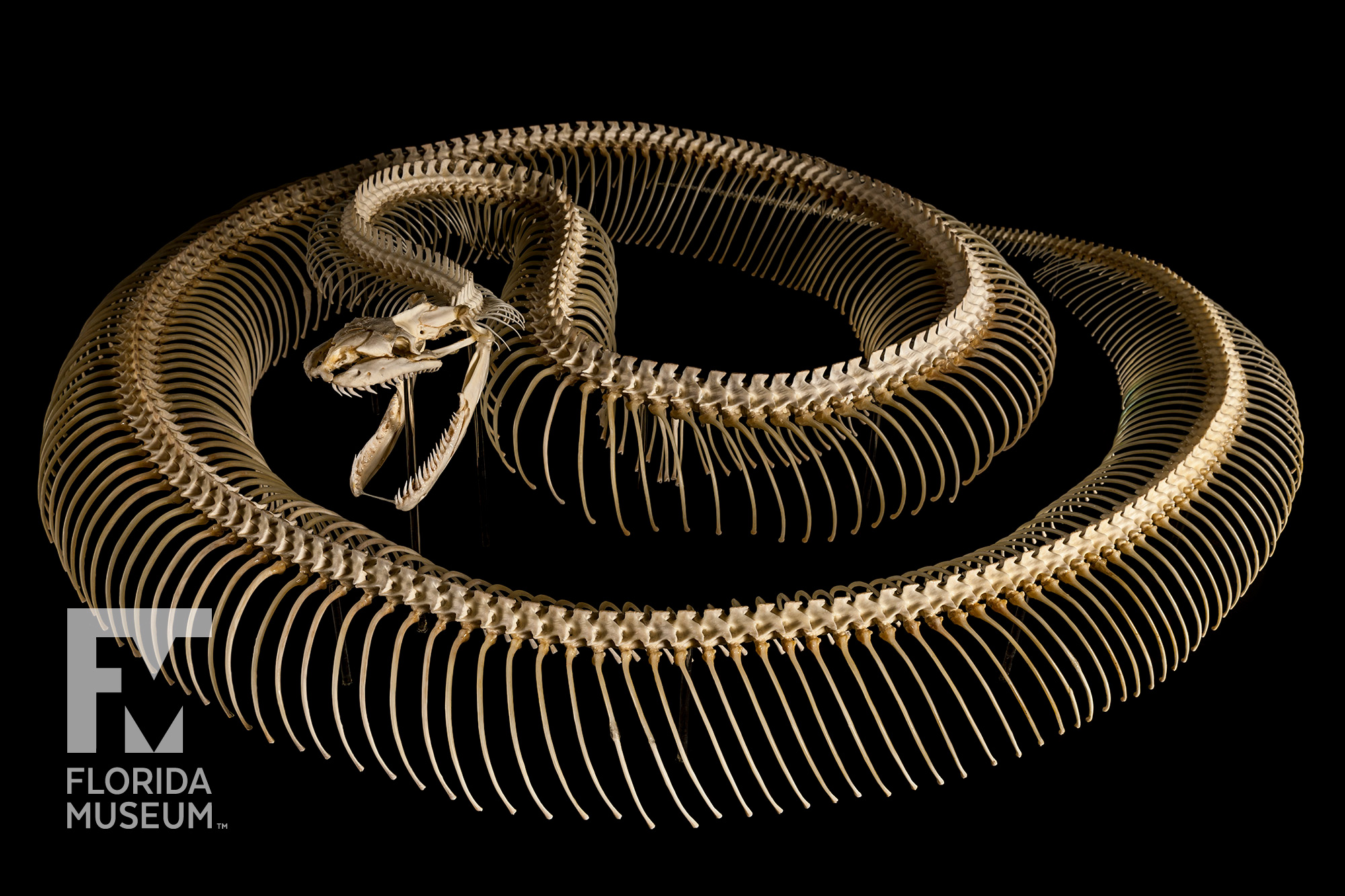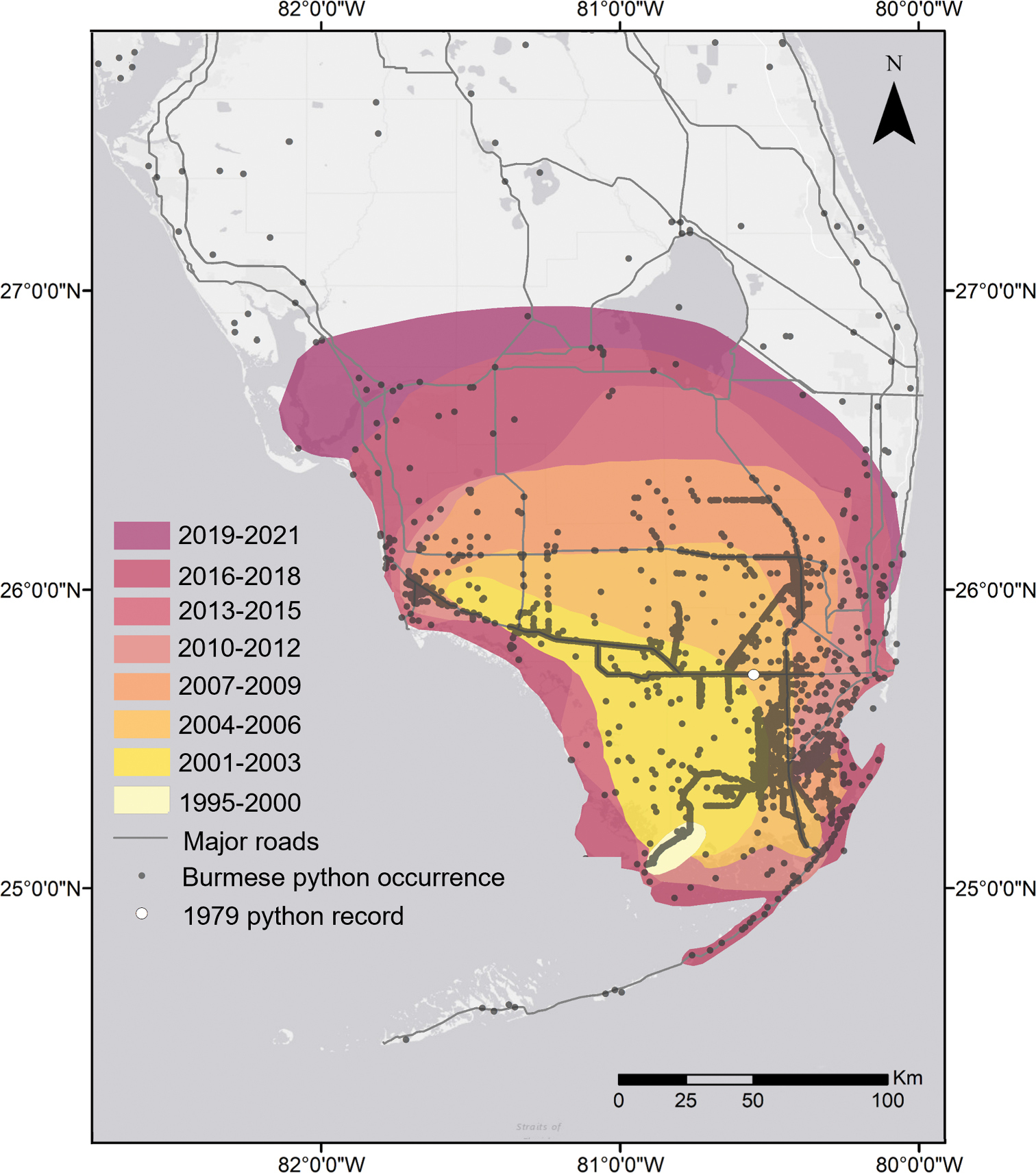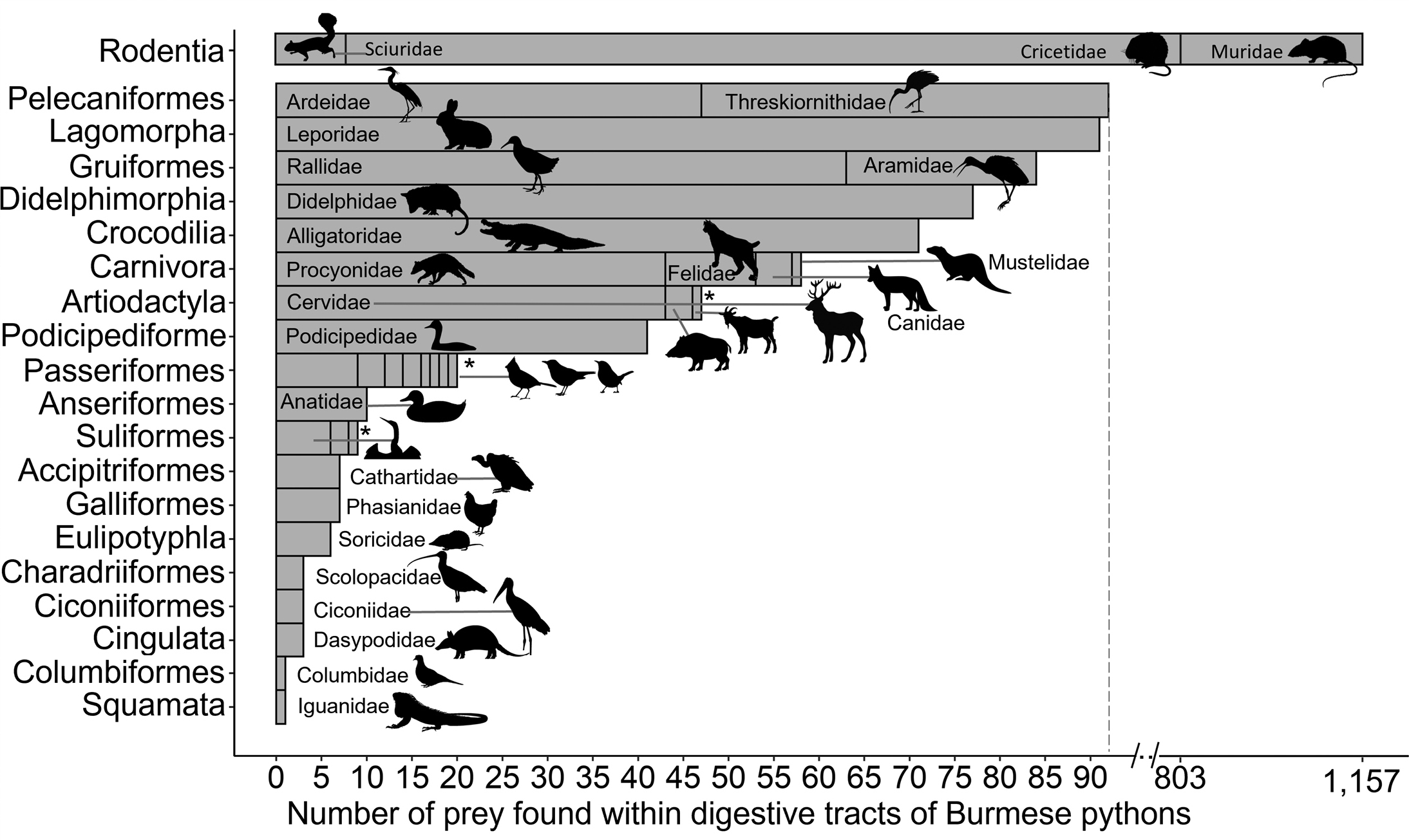Post by Life on Apr 6, 2023 19:36:27 GMT 5
The Burmese Python (Python molurus bivittatus)


Burmese Python skeleton by Robert Robins
DESCRIPTION: "This python captured the world’s attention when removed from Everglades National Park and euthanized by federal scientists in 2012. Brought to the Florida Museum for study, the 17-foot-7-inch, 164-and-a-half-pound snake is the largest Burmese python to have been found in Florida. A female, it also contained a record 87 eggs." - Florida Museum
How the Burmese Python took over the Florida Everglades?
"The first Burmese python found in the Everglades in 1979 was likely a former pet released or escaped into the wild. Today, after years of breeding, tens of thousands of the snakes inhabit the mainland around Everglades National Park, feasting on rare and endangered species." - The Nature Conservancy

----- ----- -----
Invasive Burmese python in Florida lays a record 96 eggs in one go

The 96 eggs laid by one Burmese python were dried for preservation after hatching
US Geological Survey
"A free-ranging Burmese python in Florida has laid 96 eggs in one go – the biggest number ever documented for this species.
Burmese pythons (Python bivittatus) are native to South-East Asia, but tens of thousands now live in the Everglades and surrounding areas in southern Florida, after some that were imported as pets escaped in the 1970s and established a breeding population." - New Scientist

The Burmese Python predatory prowess

A brutal toll on native wildlife

Rhona Wise / AFP via Getty Images
DESCRIPTION: "A Burmese python sits in the grass at Everglades Holiday Park in Fort Lauderdale, Fla., in 2019." - WUSF
---

Burmese Python skeleton by Robert Robins
DESCRIPTION: "This python captured the world’s attention when removed from Everglades National Park and euthanized by federal scientists in 2012. Brought to the Florida Museum for study, the 17-foot-7-inch, 164-and-a-half-pound snake is the largest Burmese python to have been found in Florida. A female, it also contained a record 87 eggs." - Florida Museum
References
----- ----- -----
How the Burmese Python took over the Florida Everglades?
"The first Burmese python found in the Everglades in 1979 was likely a former pet released or escaped into the wild. Today, after years of breeding, tens of thousands of the snakes inhabit the mainland around Everglades National Park, feasting on rare and endangered species." - The Nature Conservancy
References
----- ----- -----
Attempts to eliminate the Burmese Python in the Florida Everglades
"Since the launch of the conservancy’s python program in 2013, more than 1,000 pythons weighing more than 26,000 pounds have been removed from 100 square miles in southwestern Florida." - REPTILES
230 pythons taken from Florida Everglades in annual contest
"MIAMI (AP) — More than 230 pythons were removed from the Florida Everglades as part of an annual competition to eliminate the invasive species from the South Florida wetlands preserve.
Florida wildlife officials said Thursday that 1,000 hunters from 32 states and as far away as Canada and Latvia removed 231 Burmese pythons during the 10-day competition known as the Florida Python Challenge." - AP NEWS
Florida wildlife officials said Thursday that 1,000 hunters from 32 states and as far away as Canada and Latvia removed 231 Burmese pythons during the 10-day competition known as the Florida Python Challenge." - AP NEWS
---
215 Pound Burmese Python Removed From Florida Everglades
"The snake weighed 215 pounds and was nearly 18 feet in length." - REPTILES
---
Annual number of reported removals of Burmese pythons across southern Florida

Figure 7.
Annual number of reported removals of Burmese pythons (Python molurus bivittatus) across southern Florida through December 31st, 2021 (n=13,746). Data reported to and managed by Florida Fish and Wildlife Conservation Commission (FWC; Suppl. material 2). Pythons are predominantly removed from areas within a kilometer of a road (Fig. 6). Black bars represent the number of pythons removed through several avenues including the Florida Python Challenge, EDDMapS, State and Federal Agencies, and the FWC and South Florida Water Management District (SFWMD) paid Contractor Programs, initiated in 2017. No pythons were recorded from 1980 to 1994, as indicated by the repeating zeros on the x-axis. Overall, interpreting python abundance from unmodelled removal data is complicated by many factors, including detection probability, changes in effort, limited search areas along roads (e.g., Figs 1, 3), and potential variation in factors such as resources, habitat, and environmental conditions. Without careful population-level monitoring with baseline abundance estimates it is difficult to quantify how effective removals are, or whether removals may unintentionally result in an increase in python population abundance (see Challenges Interpreting Removal Data and Removal Programs sections). Future research goals may seek to incorporate methods to generate baseline abundance estimates (see Future Research section).
Annual number of reported removals of Burmese pythons (Python molurus bivittatus) across southern Florida through December 31st, 2021 (n=13,746). Data reported to and managed by Florida Fish and Wildlife Conservation Commission (FWC; Suppl. material 2). Pythons are predominantly removed from areas within a kilometer of a road (Fig. 6). Black bars represent the number of pythons removed through several avenues including the Florida Python Challenge, EDDMapS, State and Federal Agencies, and the FWC and South Florida Water Management District (SFWMD) paid Contractor Programs, initiated in 2017. No pythons were recorded from 1980 to 1994, as indicated by the repeating zeros on the x-axis. Overall, interpreting python abundance from unmodelled removal data is complicated by many factors, including detection probability, changes in effort, limited search areas along roads (e.g., Figs 1, 3), and potential variation in factors such as resources, habitat, and environmental conditions. Without careful population-level monitoring with baseline abundance estimates it is difficult to quantify how effective removals are, or whether removals may unintentionally result in an increase in python population abundance (see Challenges Interpreting Removal Data and Removal Programs sections). Future research goals may seek to incorporate methods to generate baseline abundance estimates (see Future Research section).
Dorcas ME, Willson JD (2013) Hidden Giants: Problems Associated with Studying Secretive Invasive Pythons. In: Lutterschmidt WI (Ed.) Reptiles in research: Investigations of ecology, physiology, and behavior from desert to sea. Nova Biomedical, 367–385.
----- ----- -----
The Burmese Python continues to hold its own against all odds in Florida
A python invasion has exploded out of the Everglades
"Burmese pythons are too good at what they do — they’re nearly undetectable to both humans and their prey, they barely need to move and when they do they’re deadly. On top of that, they have lots of babies.
As a result, according to an ambitious new paper produced by the U.S. Geological Survey, their population has exploded in only 20 years from a few snakes at the southern tip of Everglades National Park to an invasion that envelops the southern third of Florida.
As a result, according to an ambitious new paper produced by the U.S. Geological Survey, their population has exploded in only 20 years from a few snakes at the southern tip of Everglades National Park to an invasion that envelops the southern third of Florida.
The reptile’s “invasion front” has recently rolled through Broward and Palm Beach counties and is moving up the state. The current front encompasses the southern end of Lake Okeechobee and is pushing westward north of Fort Myers.
The study, which meticulously synthesizes several decades’ worth of findings from more than 250 research initiatives, assesses where we stand in the python invasion and how we might slow it." - WUSF
The study, which meticulously synthesizes several decades’ worth of findings from more than 250 research initiatives, assesses where we stand in the python invasion and how we might slow it." - WUSF
---
Invasive Burmese python in Florida lays a record 96 eggs in one go

The 96 eggs laid by one Burmese python were dried for preservation after hatching
US Geological Survey
"A free-ranging Burmese python in Florida has laid 96 eggs in one go – the biggest number ever documented for this species.
Burmese pythons (Python bivittatus) are native to South-East Asia, but tens of thousands now live in the Everglades and surrounding areas in southern Florida, after some that were imported as pets escaped in the 1970s and established a breeding population." - New Scientist
---
Geographic spread of Burmese python records in southern Florida between 1979 and 2021:

Figure 6.
Geographic spread of Burmese python (Python molurus bivittatus) records in southern Florida between 1979 and 2021. Occurrence records were obtained from a large geospatial database of invasive species reports (Early Detection & Distribution Mapping System, EDDMapS 2018) submitted by both researchers and the public. Records are classified as ‘verified’, ‘credible’, or ‘possible’, and colored polygons for each timespan are general estimates delineated using the highest densities of verified records. Polygons from 1995 through 2009 are modified from Dorcas and Willson 2011. Thus far, verified records north of Lake Okeechobee cannot be confidently attributed to the southern Florida population and may represent newly escaped individuals. The area represented by the outer polygon (2019–2021) encompasses all other polygons and represents an area of approximately 29,900 km2. The purpose of this map is to illustrate the chronology of python removals across southern Florida and represents the best professional estimate of the invasion front, which is not exact and will change over time.
Geographic spread of Burmese python (Python molurus bivittatus) records in southern Florida between 1979 and 2021. Occurrence records were obtained from a large geospatial database of invasive species reports (Early Detection & Distribution Mapping System, EDDMapS 2018) submitted by both researchers and the public. Records are classified as ‘verified’, ‘credible’, or ‘possible’, and colored polygons for each timespan are general estimates delineated using the highest densities of verified records. Polygons from 1995 through 2009 are modified from Dorcas and Willson 2011. Thus far, verified records north of Lake Okeechobee cannot be confidently attributed to the southern Florida population and may represent newly escaped individuals. The area represented by the outer polygon (2019–2021) encompasses all other polygons and represents an area of approximately 29,900 km2. The purpose of this map is to illustrate the chronology of python removals across southern Florida and represents the best professional estimate of the invasion front, which is not exact and will change over time.
Dorcas ME, Willson JD (2013) Hidden Giants: Problems Associated with Studying Secretive Invasive Pythons. In: Lutterschmidt WI (Ed.) Reptiles in research: Investigations of ecology, physiology, and behavior from desert to sea. Nova Biomedical, 367–385.
----- ----- -----
The Burmese Python predatory prowess
Prey species found within digestive tracts of Burmese pythons in southern Florida:

Figure 8.
Number of prey by order (y-axis) and family (text within bars) found within stomachs of Burmese pythons (Python molurus bivittatus). Black silhouettes are a general representation of animals within each family. Asterisks indicates several unlabeled families including eight within Passeriformes (Icteridae, Troglodytidae, Cardinalidae, Corvidae, Mimidae, Parulidae, Pycnonotidae, Regulidae), three within Suliformes (Anhingidae, Fregatidae, Phalacrocoracidae), and two within Artiodactyla (Suidae, Bovidae). Data from Table 3 and Romagosa et al. (2022).
Number of prey by order (y-axis) and family (text within bars) found within stomachs of Burmese pythons (Python molurus bivittatus). Black silhouettes are a general representation of animals within each family. Asterisks indicates several unlabeled families including eight within Passeriformes (Icteridae, Troglodytidae, Cardinalidae, Corvidae, Mimidae, Parulidae, Pycnonotidae, Regulidae), three within Suliformes (Anhingidae, Fregatidae, Phalacrocoracidae), and two within Artiodactyla (Suidae, Bovidae). Data from Table 3 and Romagosa et al. (2022).
Dorcas ME, Willson JD (2013) Hidden Giants: Problems Associated with Studying Secretive Invasive Pythons. In: Lutterschmidt WI (Ed.) Reptiles in research: Investigations of ecology, physiology, and behavior from desert to sea. Nova Biomedical, 367–385.
---
A brutal toll on native wildlife
"When biologists open the invasive snakes up, it’s like rifling through a Florida field guide. All told, they’ve found 76 prey species inside the snakes. That includes lots of birds, such as vultures, crows, ducks, herons, roseate spoonbills and threatened wood storks; small mammals such as the endangered Key Largo woodrat and Key Largo cotton mouse, marsh rabbits, armadillos, possums, raccoons, otters and domestic cats, and larger prey including domestic goats, white-tailed deer, wild hogs and alligators. There has never been a documented human death due to a wild python in Florida.
How much damage have they done? Guzy points out that before 2000, researchers could frequently spot mammals in Everglades National Park. But from 2003 to 2011, the frequency of mammal observations [raccoons, opossums, bobcats, rabbits, gray foxes, and white-tailed deer] declined by 85% to 100%. Outside the python’s range, those species were more common.
The snakes also competed with native predators, like bobcats. One study released marsh rabbits in areas with and without pythons. In python areas, the snakes accounted for 77% of rabbit mortalities within 11 months. At other sites, no rabbits were killed by pythons and mammal predators accounted for 71% of the marsh rabbit deaths. Marsh rabbit declines in southern Florida were caused by pythons, other studies showed." - SunSentinel
The snakes also competed with native predators, like bobcats. One study released marsh rabbits in areas with and without pythons. In python areas, the snakes accounted for 77% of rabbit mortalities within 11 months. At other sites, no rabbits were killed by pythons and mammal predators accounted for 71% of the marsh rabbit deaths. Marsh rabbit declines in southern Florida were caused by pythons, other studies showed." - SunSentinel

